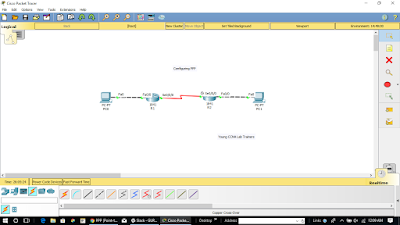Hi ! everyone on today we are going to learn about PPP and their types in brief which is shown below.
PPP is a WAN protocol that works at layer 2 by encapsulating frames for transmission over a variety of physical links such as serial cables, cell phones, fiber optic cable among others. it offers many more features as compared to HDLC and it is an open standard. Some of the features that it offers which are not available in HDLC include:
- Link quality management which is a way to monitor the quality of a link in PPP. When PPP detects too many errors on a link, the link is shut down.
- Authentication using PAP and/or CHAP
PPP operation is made using three parameters:
- Encapsulation of frames using HDLC protocol
- LCP (Link Control Protocol) for establishment, configuration and testing of the link
- NCP (Network Control Protocols) to negotiate the different layer 3 protocols.
Link Control Protocol (LCP)
This is the main protocol that PPP uses for its operation. LCP works on top of layer 1 and it works by establishing, testing and configuring the physical connection. It also negotiates other WAN options that are handled by the NCPs. LCP configures the link in the ways listed below:
- Determining transmission of different packet sizes
- Detection of misconfiguration errors
- Termination of the link
- Determination of link failure
LCP is also used to negotiate encapsulation parameters and other PPP configuration options such as authentication, error detection and compression when the link has been established.
Network Control Protocol Layer
NCPs are protocols that allow PPP to use different layer 3 protocols such as IP, IPX and Apple Talk.
Establishing a PPP Session
When establishing a PPP session, LCP negotiates the PPP configuration options at either point of the link. This is completed when acknowledgment frames are sent.
The second step is usually optional and it is where LCP tests the link to ascertain whether it has the needed quality to support the various layer 3 protocols.
Finally, NCP is used to configure the layer 3 protocols that are in use.
Configuring PPP
Now that we have learnt the workings of PPP, we can go ahead and configure it. The figure below shows the topology that we will be using in the configuration of PPP.
In our lab, all the options for the PCs as well as the interfaces connecting to the routers from the PCs are configured. The routers have been correctly configured and our task is only to configure the PPP options on the serial links.
The lab requires that we configure basic PPP and successful completion of the lab will be determined by the verification commands we learnt earlier.
Encapsulation
The main command used to enable PPP is: “encapsulation ppp” command. This command should be entered in the serial interface of the routers as shown below.
Router(config)#interface serial<INTERFACE_ID>
Router(config-if)#encapsulation ppp
The command shown above does not have any other options, however, to use PPP, you must have a layer 3 protocol.
In our scenario, all we need to do is to enter this command on the serial interfaces of R1 and R2 as shown below.
R1(config)#interface serial 0/0/0
R1(config-if)#encapsulation ppp
R2(config)#interface serial 0/0/0
R2(config-if)#encapsulation ppp
Link quality percentage
As we mentioned earlier, the quality of a link is crucial to PPP. The link quality percentage configuration parameter is used to set the baseline quality percentage. When the link does not meet the specified quality, PPP does not activate the link.
The link quality is usually maintained by a parameter called LQM (Link Quality Monitoring) which uses a time lag to make sure that the line does not fluctuate.
To implement link quality percentage as a requirement for PPP establishment, we use the command: “ppp quality <PERCENTAGE>” in the interface configuration mode, this is shown below for our scenario.
R1(config-if)#ppp quality 80
R2(config-if)#ppp quality 80
This will ensure that the link meets this threshold for PPP to work.
Multilink PPP
Multilink PPP is a way to use many physical WAN links with PPP. This in effect allows for load balancing.
The command for configuring multilink PPP is: “ppp multilink” in the interface configuration mode as shown below for R1 and R2.
R1(config-if)#ppp multilink
R2(config-if)#ppp multilink
NOTE: the quality and multilink commands are not frequently used, and they may not work on Packet tracer simulator.
Verification and Troubleshootingof ppp
To verify PPP configuration, the “show interface serial <interface_ID>”, “show interfaces” and “debug ppp” commands are mostly used. In this course however, we will mainly use the “show interfaces <interface_ID>” command, the output of this command is shown below.
NOTE: the interface status is one of the most important diagnostic features of serial interfaces as discussed in the previous chapter. The debug commands will give live updates for ppp on the router they are issued.
PPP authentication
In PPP, we can secure communication between two points using authentication. There are two ways in which we can configure PPP authentication as discussed below.






No comments:
Post a Comment